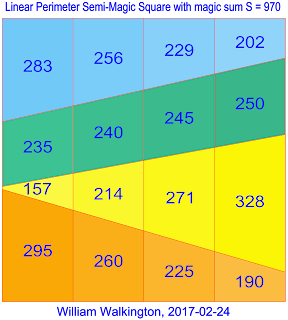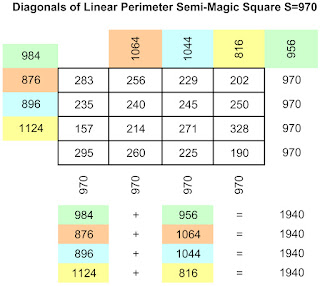After the first discoveries of area magic squares, I decided to do some more exploring and search for examples of perimeter magic squares. I found that the latter do indeed exist, and that although these appear to be similar to linear area magic squares, their construction is quite different for two reasons: Depending on the slopes (and lengths) of the slanting dissection lines of a perimeter magic square, the hinge points of these lines are offset when compared with those of an area magic square. The total perimeter of a perimeter magic square results from the slopes (and lengths) of the slanting dissection lines, and not from the addition of the individual cell perimeters.
Unless stated otherwise, the perimeter magic squares illustrated here have been created by the author of this post. Although perimeter magic squares are shown to be different from area magic squares, they were deduced using Walter Trump's area magic square construction techniques.
For want of a better word, please note that these perimeter magic squares are measured geometric perimeter magic squares, and that they are therefore not to be confused with the square examples of perimeter-magic polygons, (first created by Terrel Trotter Jr. and further discussed on the website of Harvey Heinz).
Linear Perimeter Magic Square of Order-3
On the 25th February 2017, the first Linear Perimeter Magic Square (L-PMS) of Order-3 was constructed using AutoCAD:
This L-PMS is drawn to a precision of 2 decimal places for each of the 9 cell perimeters, and the resulting total perimeter of the square is therefore approximately 47.372 (before computer validation and optimisation). The coordinates of this square are available upon request.
Maybe the square perimeters of such L-PMS of order-3 are proportional to the regular consecutive number cell perimeter sequences that they display, and those amongst you with programming skills will be able to generate different similarly-constructed examples, and thus identify the relationship?
Linear Perimeter Magic Squares of Order-4
The following Semi-Orthogonal Linear Perimeter Magic Squares (L-PMS) of order-4 have cell perimeter entries rounded to 6 digits. Because their central slanted lines are not derived from Pythagorean triangles, the lengths of the adjoining cell perimeters are not finite integers, but irrational "infinite" numbers. The precision of the cell perimeters can be further increased, but with each increase in precision the cell entries and the corresponding magic sums become higher, and the dimensions have to be modified accordingly.
Constructed on the 23rd February 2017, the following L-PMS of order-4 has a rounded magic sum of S = 1936532:
The upper slanted line is derived from a Pythagorean triangle with long leg 24, short leg 7, and hypotenuse 25. The central slanted line is derived from a triangle with long leg 120, short leg 8, and hypotenuse 120.26637102698... The lower slanted line is derived from a Pythagorean triangle with long leg 40, short leg 9, and hypotenuse 41. The total sum of the 16 cell perimeters is 1936532 x 4 = 7746128. The average cell perimeter is 7746128 / 16 = 484133. The perimeter of the magic square is 120000 x 4 x 4 = 1920000. The coordinates of this square are available upon request. This perimeter magic square's cell values are voluntarily rounded to 6 digits. Greater accuracy is possible, but this will inevitably lead to very high entries. If more or less digits are used for the cell perimeter values, then the slanted lines will need vertical translations to take into account the revised magic sums, and this will imply new dimensions. There are some interesting relationships between the broken diagonals of this linear perimeter magic square (L-PMS), as shown in the following diagram:
Constructed on the 24th February 2017, the following L-PMS of order-4 has a rounded magic sum of S = 1930156:
The upper slanted line is derived from a Pythagorean triangle with long leg 1200, short leg 49, and hypotenuse 1201. The central slanted line is derived from a triangle with long leg 120, short leg 26.9, and hypotenuse 122.978087479... The lower slanted line is derived from a Pythagorean triangle with long leg 60, short leg 11, and hypotenuse 61. The total sum of the 16 cell perimeters is 1930156 x 4 = 7720624. The average cell perimeter is 7720624 / 16 = 482539. The perimeter of the magic square is 120000 x 4 x 4 = 1920000. The coordinates of this square are available upon request. This perimeter magic square's cell values are voluntarily rounded to 6 digits. Greater accuracy is possible, but this will inevitably lead to very high entries. If more or less digits are used for the cell perimeter values, then the slanted lines will need vertical translations to take into account the revised magic sums, and this will imply new dimensions. There are some interesting relationships between the broken diagonals of this linear perimeter magic square (L-PMS), as shown in the following diagram:
Perhaps a reader with programming skills will be tempted to find the first semi-orthogonal linear perimeter magic square of order-4 with all slanted diagonals derived from Pythagorean triangles, and therefore endowed with finite integer values for its cell entries?
Linear Perimeter Semi-Magic Squares of Order-4
For comparison with the above examples of linear perimeter magic squares with rounded cell entries, the following linear perimeter semi-magic squares of order-4 are each constructed with all three slanting lines derived from Pythagorean triangles. Their individual cell perimeters can thus be defined as integers, and the resulting cell entries and magic sums of these perimeter semi-magic squares are therefore rational and finite.
Constructed on the 24th February 2017, the following linear perimeter semi-magic square (L-PSMS) has a magic sum of S = 15492:
The upper slanted line is derived from a Pythagorean triangle with long leg 24, short leg 7, and hypotenuse 25. The central slanted line is derived from a Pythagorean triangle with long leg 480, short leg 31, and hypotenuse 481. The lower slanted line is derived from a Pythagorean triangle with long leg 40, short leg 9, and hypotenuse 41. The total sum of the 16 cell perimeters is 15492 x 4 = 61968. The average cell perimeter is 61968 / 16 = 3873. The perimeter of the semi-magic square is 960 x 4 x 4 = 15360. The coordinates of this square are available upon request. There are some interesting relationships between the broken diagonals of this linear perimeter semi-magic square (L-PSMS), as shown in the following diagram:
Also constructed on the 24th February 2017, the following linear perimeter semi-magic square (L-PSMS) has a magic sum of S = 970:
The upper slanted line is derived from a Pythagorean triangle with long leg 40, short leg 9, and hypotenuse 41. The central slanted line is derived from a Pythagorean triangle with long leg 60, short leg 11, and hypotenuse 61. The lower slanted line is derived from a Pythagorean triangle with long leg 24, short leg 7, and hypotenuse 25. The total sum of the 16 cell perimeters is 970 x 4 = 3880. The average cell perimeter is 3880 / 16 = 242.5. The perimeter of the semi-magic square is 60 x 4 x 4 = 960. The coordinates of this square are available upon request. There are some interesting relationships between the broken diagonals of this linear perimeter semi-magic square (L-PSMS), as shown in the following diagram:
Further Developments
If anyone wishes to contribute linear or strict geometrical constructions of other perimeter magic squares, then please send me the x and y coordinates of the cell intersections that define the perimeters correctly up to two or more decimal places. No prizes can be given, but the authors of pertinent solutions will, if they wish, have their solutions published here.
A new post on "Polyomino Area Magic Tori" (PAMT) can be found in this blog since the 7th June 2022. Perhaps these PAMT will suggest new possibilities for the exploration of polyomino perimeter magic squares (PPMS) and polyomino perimeter magic tori (PPMT)...










No comments:
Post a Comment
Or, should you prefer to send a private message, please email william.walkington@wandoo.fr